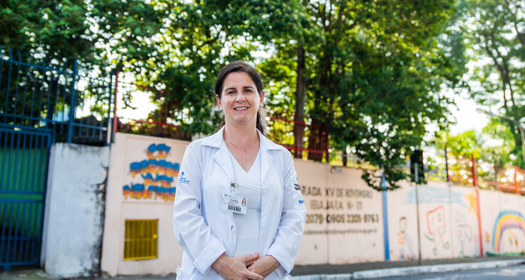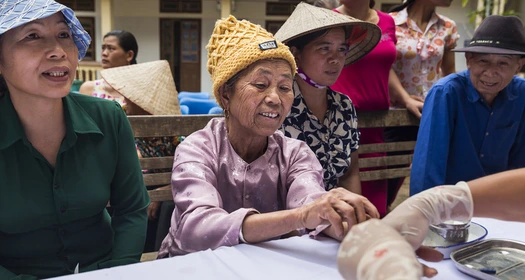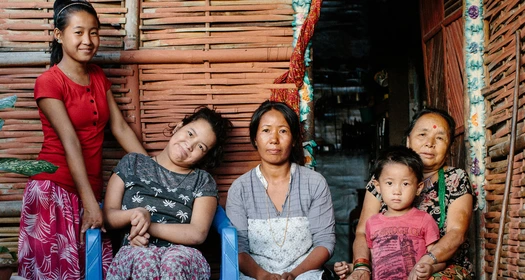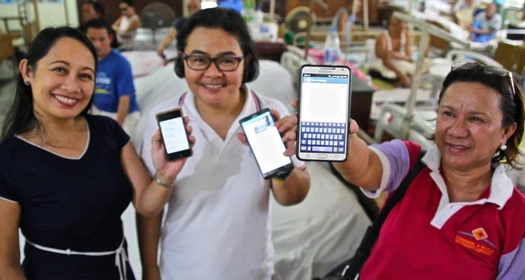To better prevent the main cardiovascular (CV) risk factors and improve care at the population level, continuous medical education of primary healthcare workers needs to align with the internationally accepted latest evidence and best practices for the management of cardiovascular disease (CVD). Guidelines from the World Health Organization, the World Heart Federation, the European Society of Cardiology, or the American College of Cardiology/American Heart Association can be tailored to local requirements and procedures. This requires updating prevention, diagnosis and care protocols and translating them into clinical decision support tools. Health professionals at all levels then need to be trained on how to use those protocols and the potential new techniques, tools and equipment for screening, diagnosis and treatment of CVD. To successfully reduce CV risk in urban populations, it is also essential to coordinate health and care between providers at all levels, and to actively engage patients in managing their own health.
Quality of care
- Standardize hypertension management through updated guidelines and algorithms, and train health workers on the use of standard protocols, while providing them with clinical decision support tools and regular supportive supervision by city health managers
- Introduce task-shifting to increase overall coverage and efficiency of primary health services
- Improve care coordination and patient referrals between providers and care levels to ensure people receive the best possible care close to where they live, work or play
- Engage patients in managing their own health by educating them on the importance of controlling their numbers, of treatment adherence and healthy lifestyles
The indicators below can come from a variety of sources (primary and secondary data collection, national or regional surveys and databases).
Standardization of hypertension prevention, diagnosis, treatment and follow-up
- Protocols/guidelines updated with the latest available evidence
- Protocols translated into standard algorithms and clinical decision support tools
- # of doctors, nurses, pharmacists and community health workers trained on standard protocols, algorithms and clinical decision support systems
- # of non-traditional health players trained and engaged in early detection, referral and follow-up
- # of non-traditional health players trained and engaged in the delivery of health information on CV risks to the public
Hypertension screening and diagnosis
- Expected number of people with hypertension in the target population (expected prevalence) – hypertension being defined as a blood pressure (BP) of either >140/90 or >130/80 mmHg, depending on national guidelines
- # of people screened
- % of total target population screened for hypertension (screening coverage)
- # of people diagnosed with hypertension
- % of people diagnosed with hypertension compared to the expected number of people with hypertension in a population (diagnosis coverage)
- # of primary health centers with a hypertension screening corner systematically measuring BP of all their foot traffic (i.e. everyone visiting the health center, regardless the reason)
Treatment and follow-up
- % of patients diagnosed and initiated on treatment
- % of patients adhering to treatment for 3 months, 6 months, 1 year
- % of patients on treatment with controlled BP after 3 months, 6 months, 1 year
- % of patients on treatment attending follow-up visits at 3 months, 6 months, 1 year
- % of patients with controlled BP who remain controlled after 3 months, 6 months, 1 year
Coordination of care and patient referrals
- % of people diagnosed with high BP in a checkpoint outside the health system, who visit the health center to confirm diagnosis and initiate treatment
- % of lost to-follow-up patients referred to the health center by the outreach team (community members, community health workers)
- % of patients with severe or complicated hypertension referred to specialist care
- % of treated patients experiencing acute CV events or other signs of organ damage (indicating late referral)
- % of referred patients who are followed up in primary care after returning from out- or inpatient referral services (in secondary/tertiary healthcare)
Task shifting for hypertension management
- % of health centers in the city where nurses or community health workers are responsible for systematic BP measurement and hypertension diagnosis
- % of health centers in the city where nurses or community health workers are responsible for counseling and educating hypertension/CVD risk patients
- % of health centers in the city where nurses or community health workers are responsible for initiating treatment and prescribing first-line antihypertensive medicines
- % of health centers in the city where nurses or community health workers are responsible for long-term follow-up of hypertension treatment
Supportive supervision of primary healthcare workers
- # of city health managers performing regular supervision visits/assessment of primary health centers and workers
- % of urban primary health centers receiving one or more supervision visits from their city health authority/manager every 6 months, per year
- % of supervised consultations for hypertension in the city’s primary health sector (compared to the total consultations for hypertension)
Patient engagement and self-management
- % of treated patients who are aware of their BP numbers
- % of treated patients able to self-measure their BP
- % of patients aware of lifestyle risk factors for CVD and of ways to alter those
- % of patients with access to digital tools to support self-care and reinforce treatment adherence (e.g., SMS reminders to take their medication and get refills)
Additional external resources
Guidelines
- 2020-2022 Hypertension Highlights - A Practical Guide informed by the Hypertension Canada Guidelines for the Prevention, Diagnosis, Risk Assessment, and Treatment of Hypertension
- 2017 ACC/AHA/AAPA/ABC/ACPM/AGS/APhA/ASH/ASPC/NMA/PCNA Guideline for the Prevention, Detection, Evaluation, and Management of High Blood Pressure in Adults. JACC 2018
- 2020 International Society of Hypertension Global Hypertension Practice Guidelines. Hypertension. 2020;75:1334–1357
- Guidelines for the Early Management of Patients With Acute Ischemic Stroke: 2019 Update to the 2018 Guidelines for the Early Management of Acute Ischemic Stroke: A Guideline for Healthcare Professionals From the American Heart Association/American Stroke Association. Stroke. 2019;50:e344–e418
- 2018 ESC/ESH Clinical practice guidelines for the management of arterial hypertension. European Heart Journal 2018
Reference documents and literature
- WHO Cardiovascular Diseases. 2021
- WHO HEARTS technical package. 2021
- WHO Noncommunicable diseases country profiles 2018 with important national data on CV risk factors and CVD
- Task sharing with non-physician health-care workers for management of blood pressure in low-income and middle-income countries: a systematic review and meta-analysis. The Lancet 2019
- World Heart Federation: A Roadmap on the Prevention of Cardiovascular Disease Among People Living With Diabetes. 2019
- Modifiable risk factors, cardiovascular disease, and mortality in 155 722 individuals from 21 high-income, middle-income, and low-income countries (PURE): a prospective cohort study. The Lancet 2019
- American Heart Association: Call to Action: Urgent Challenges in Cardiovascular Disease. Circulation. 2019;139:e44–e54.
- CTT Collaboration: Efficacy and safety of more intensive lowering of LDL cholesterol: a meta-analysis of data from 170 000 participants in 26 randomised trials. The Lancet 2010; 376:1670-81
- eTIQH tool for supportive supervision in primary health centers by health system managers. Towards improved health service quality in Tanzania: contribution of a supportive supervision approach to increased quality of primary healthcare. BMC Health Services Research, 2019, 19:848.
Recommendations described herein were developed by the Novartis Foundation and/or its partners as part of the Better Hearts Better Cities and other initiatives; before local implementation, interested parties must ensure compliance with all applicable laws and regulations, including local industry codes and institutional policies. Links and content may be subject to change without notification.
The Terms of Use of the Novartis Foundation apply.









